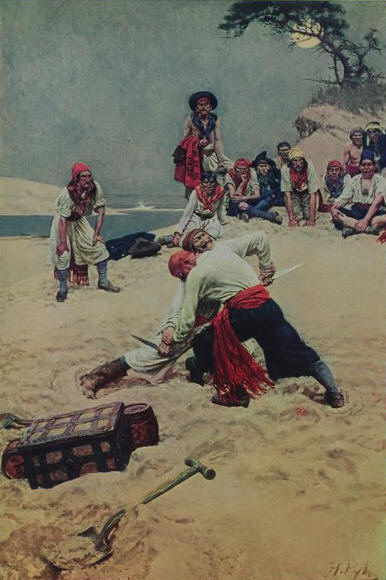
Fleet Info
Pirate Related Info
 In
popular folklore pirate treasure would mean sea chests overflowing with
pieces of eight, plundered diamonds and other exotic gems... but this
was not usually the case. Although it may have been their goal to do so, most western pirates mainly
attempted to attack lightly armed merchant ships. They normally came away with booty like a few bales of silk or cotton, some barrels of rum or tobacco, carpentry and navigation tools. Maybe spare canvas for sail, rope, food, medicine, weapons, and a few pieces of eight. They might also try and recruit new members from their captives or perhaps just take the entire ship as a prize.
In
popular folklore pirate treasure would mean sea chests overflowing with
pieces of eight, plundered diamonds and other exotic gems... but this
was not usually the case. Although it may have been their goal to do so, most western pirates mainly
attempted to attack lightly armed merchant ships. They normally came away with booty like a few bales of silk or cotton, some barrels of rum or tobacco, carpentry and navigation tools. Maybe spare canvas for sail, rope, food, medicine, weapons, and a few pieces of eight. They might also try and recruit new members from their captives or perhaps just take the entire ship as a prize.
Although buried treasure has been a favorite theme in the pirate stories of fiction, there are very few documented examples of real pirates who buried their plunder. Most pirates preferred to spend their booty in an orgy of drinking, gambling, and whoring when they returned to port. In the Golden Age of Piracy the great riches of the Spanish Main are what attracted many pirates to that area of the world. It has been calculated that when the Spanish treasure fleet made its annual visit to Portobello to load up the treasure from Peru, there was likely to be 25 million pesos in silver bars and coins in the town. (This was twice the annual revenue of the King of England at that time) As you can imagine the rewards of piracy could be fantastic and some daring pirates acquired enormous wealth. But the kind of 'treasure' taken by pirates differed all over the world.

NEW WORLD PIRATES
This was one of the most popular areas for
pirate activity. Spain's conquests in the 16th century had given it a
large amount of land. This land included area from California down to
South America. It was a very rich land, full of minerals and the
treasures of the Aztec and Incas. This area is what was called the
Spanish Main. The Spanish looted this treasure and shipped it through
the Caribbean to Spain. Cargos were very rich indeed! According to
Stewart Ross' book Pirates (Aladdin Books Ltd., 1995, p. 10), when Sir
Francis Drake "raided Nombre de Dios in 1572 he seized 15 tons of gold
and thousands of silver coins!" It is no surprise then that this area
was a favorite hunting place for pirates looking for treasure ships
loaded with booty to plunder.
MEDITERRANEAN PIRATES
In this same time period European Christians who sailed along
the coast of Algiers, Tripoli, and Tunis called the Muslims barbarians,
and the area thus became known as the Barbary Coast. The pirates from
this area were called Corsairs and were not generally involved in piracy
for gold or pieces of eight. The treasure they were trying to capture
was people, whom they held for ransom, used as oarsmen on their galleys,
or just sold as slaves.
INDIAN OCEAN PIRATES
A third area for piracy was one of the great trade routes in
the world - the Indian Ocean. After 1497-1498, when Vasco da Gama sailed
around the Cape of Good Hope, the trade routes opened up and became more
popular with European traders... and also with pirates. Cargos in the
Indian Ocean were just as valuable as those in the Caribbean. But
instead of gold or silver the booty these ships contained were very
valuable silk, jewels, ivory and spices such as pepper, nutmeg and
cinnamon. Most pirates preferred to operate out of just one of these
regions of the world. But some pirates were known to have plundered
booty in several areas of the world over the course of their career.